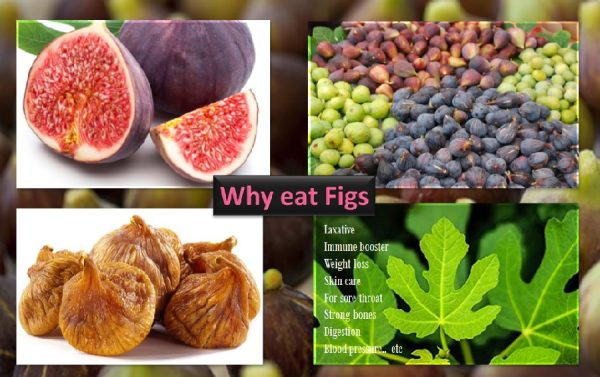
Why we should eat figs
Figs are one of the healthy, nutritious fruits available both in fresh and dry forms. Figs are native to middle east and Mediterranean. Eventually, like many other popular fruits, because of its nutrition and medicinal values fig trees are growing in many parts of the world where the climate supports fig’s growth.
Figs fruits have a unique structure and taste. The soft and chewy fruit has crunchy tiny seeds inside. The perishable fresh fig fruits taste different than dried figs. After drying fig fruits tastes sweeter and more marketed throughout the world. Did you know that because of its sweet nature figs used to sweetener for dishes before refined sugar came to existence?
Depending on the variety of figs, its color and texture vary. Following fig varieties are common –
- Black Mission: Black purple skin with pink colored flesh
- Kadota: Purplish flesh with green skin.
- Calimyrna: Amber color flesh and greenish yellow skin.
- Brown Turkey: Red flesh and purple skin type
- Adriatic: Light pink flesh and light green skin
Why we should include figs in our diet?
- Figs are highly recommended because it nourishes and tones the stomach. It acts as a natural laxative as it contains good amount of digestive fiber.
- Figs supports gut and aids good digestion.
- Figs are good source of calcium and hence is good for bone. For people who have family history of osteoporosis, figs is a good choice of food.
- Fresh figs helps to increase potassium and is a good remedy for high blood pressure.
- Figs are also good source for trace minerals like manganese.
- Apart from fiber, figs also contain Vitamin B, potassium, pantothenic acid.
- For those who are on diet program, figs can be a good addition in the diet. Its fiber gives fullness to stomach and helps in controlling hunger and cravings.
- Another health benefit of eating dry figs is, in adults it lowers risk of age related macular degeneration or ARMD. Eating three or more servings of figs – including in breakfast, as dry fruit dish, adding in yogurt or eating as snack – will help in adults to maintain their vision.
- Fully ripened fig fruits contain more amount of antioxidants.
- Apart from fig fruits, fig leaves – young fig leaves are edible. These leaves have antidiabetic properties and helps to balance the insulin.
- Fig leaves also helps to reduce triglycerides, the type of fat present in bloodstream.
- In traditional medicines, both finely crushed fruit and leaves added with salt for gargling to relieve sore throat. The mucilage content in fig helps to heal the throat.
- Fig leaves tea is good remedy for bronchitis.
- Fig is a powerful fertility supplement and to get benefit add fig paste to a cup of milk and drinking helps.
- Because of its laxative effect, consuming soaked dried figs helps to reduce pile. It reduces pressure on anus and helps to soothe hemorrhoids.
- Another benefit of eating figs is, it reduces risk of memory loss and Alzheimer’s disease.
- Presence of flavonoids, alkanes in fig helps to maintain pH of the skin and body. Eating fig reduces certain skin irritation.
Both fresh and dry figs are good for health. They both contain powerful antioxidants. The nutritional value of dry figs is more or increases by weight because they are dried. A 100 gram fresh figs provides 35 mg of calcium and 100 gram of dried figs provides 162 mg of calcium. One should consume figs in moderation because they contain good amount of sugar in the form of fructose.
There are different ways to include figs in our diet
- Add in your breakfast cereal.
- In a food processor add dry dates and figs, chop and prepare small balls. If you prefer add few cashews, raisins and cardamom powder! You can snack these balls – just like nutrient bar
- While preparing mixed fruit juice add either fresh fig or dry figs
- Fig spread is healthier option than sugar. It can be incorporated in cakes, assorted baked goods, pies and preserves.
Image credit: Photo by Weronika Marcińczyk on Unsplash , Photo by Tina Vanhove on Unsplash & Photo by Bodie Pyndus on Unsplash (Free for commercial uses)
Author: Sumana Rao | Posted on: November 4, 2019
« Grandma’s Remedies for Minor Burns Amla, amla juice and benefits »






















Write a comment